Issue #77 – May 23
Welcome to Focus on Fatigue!
We are often asked for advice on how to assess whether fatigue contributed to an incident and if it can be determined simply by looking at the FAID Score at the time of the incident? The short answer is no. A systematic and situation-specific assessment is required to determine whether fatigue was a contributing factor to an accident or incident.
In this issue of Focus on Fatigue, we will provide some insight into this process.
We trust you find it useful and informative.
The FRMS Team
Views expressed in articles and links provided are those of the individual authors, and do not necessarily represent the views of InterDynamics (except where directly attributed).
Assessing Fatigue as a Contributing Factor to an Incident
Fatigue is a serious and complex issue and many organisations struggle with how to assess and determine whether fatigue contributed to an incident or accident. So, let’s have a look at this process. We will provide an overview of the information needed for a thorough investigation and identify personal and corporate/systemic fatigue-related contributors. We will also introduce the GRAID Investigation Tool, which can assist organisations in this assessment process.
Specific Details of the Occurrence
To assess whether fatigue was a contributing factor to an incident, you need to collect specific details of the occurrence. This includes timing, personnel involved, context, and incident details. This information will help you understand the circumstances surrounding the incident and determine whether fatigue may have played a role.
Preliminary Details
Once you have collected the specific details of the occurrence, you need to consider preliminary details related to the individuals involved and the circumstances surrounding the incident. This involves assessing factors such as:
- FAID Quantum hours of work assessment
- workload impacts
- work environment impacts
- non-compliance to work/rest rules
- self assessed Karolinska Sleepiness Scale
- self observed symptoms/behaviours
- personal health/medication
- third-party observations of symptoms/behaviours.
Assessing these questions will give you an initial determination as to the likelihood that fatigue was a significant contributing factor. If the likelihood is low, then no further investigation may be necessary. However, if the likelihood is not determined to be low, further investigation is warranted.
Personal and Corporate/Systemic Fatigue-Related Contributors
The next stage of the investigation involves assessing both personal and corporate/systemic fatigue-related contributors. Factors to consider include:
- the use of rest days
- secondary employment
- jetlag/significant recent time zone changes
- prior sleep in the previous 48 hours
- fatigue-related training
- sleep disturbance due to alcohol
- commute time prior to the occurrence
- sleep inertia
- fatigue detection technology
- quality of employer-provided sleeping environment
- predictability of working hours
- medical screening and monitoring
- record of absenteeism/sick days
- expectations and incentives that may increase personal fatigue
- whether rostering practices take into account fatigue
- alerting strategies and control measures
GRAID Investigation Tool
The GRAID Investigation Tool by InterDynamics was developed, together with Integrated Safety Support, to assist organisations in this assessment process. The tool applies a risk grading system developed by Zurich Risk Engineering and offers a consistent and practical approach to reviewing incidents, accidents, occurrences, and fatigue reports.

GRAID IT systematically steps the user through a review of 28 weighted fatigue-related elements. Once the investigation is complete, GRAID IT provides a grading of the likelihood that fatigue contributed to the occurrence, and the related scorecard can be reviewed. By taking a systematic approach to assessing fatigue, organisations can identify contributing factors and take steps to prevent future incidents.
In The News
Provided below are a selection of articles from around the web on the issues associated with fatigue. We hope you find them useful and interesting.
Reducing fatigue and errors among nurses working night shifts
Nurses exposed to 40 minutes of bright light before their night shifts feel less fatigued and make fewer errors at work, according to a study led by McGill University. The nurses also slept better after their shifts.
Driving on less than 5 hours of sleep is just as dangerous as drunk-driving, study finds
A new study has found that if you had less than five hours of sleep last night you are just as likely to have a vehicle crash as if you were over the legal limit of alcohol.
RTD says light rail operator “likely fell asleep” before W-Line train derailed at Golden station
Transit agency’s corrective plan proposes evaluating shift durations and fatigue-awareness campaign.

